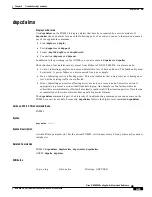
9-63
Cisco MGX 8850 Routing Switch Command Reference
Release 2.0, Part Number 78-10467-04 Rev C0, October 2001
Chapter 9
Troubleshooting Commands
dspcdalms
dspcdalms
Display Card Alarms
Use dspcdalms on the PXM45 to display alarms that have been reported by a service module. If
dspcdalms shows an alarm for one of the following parts of a card, you can cc to that card and execute
one of the applicable commands:
•
Line (dsplns and dspln)
•
Port (dspports and dspport)
•
Feeder (dspfdr, dspfdrs, and dspfdrstat)
•
Connection (dspcons and dspcon)
In addition to the preceding, on the AXSM you can also execute dspalm and dspalms.
The definition of each alarm severity comes from Bellcore TR-NWT-000474. An alarm can be:
•
Critical, indicating complete, non-recoverable failure, loss of data, and do on. The failed entity must
be restored. A power failure or a disconnected line is an example.
•
Major, indicating service-affecting errors. This event indicates that a major service is damaged or
lost, but the existing traffic is not affected.
•
Minor, indicating non-service affecting errors or errors on a remote node. Corrective action is
appropriate to prevent a serious fault from developing. An example is a fan failure, where no
subscribers are immediately affected, but calamity could result if the situation persists. Note that an
accumulation of lower-level alarms does equal a higher-level alarm.
The dspcdalms command is part of a hierarchy of troubleshooting commands you can execute on the
PXM45 or a service module. Frequently, dspcdalms follows the higher-level command dspndalms.
Cards on Which This Command Runs
PXM45
Syntax
dspcdalms [slot]
Syntax Description
slot identifies a particular slot. For the current PXM45, slot is unnecessary. For any other card, you must
include slot.
Related Commands
PXM45: dspndalms, dspslotalms, dspswalms, dspclkalms
AXSM: dspalm, dspalms
Attributes
Log: no log
State: active
Privilege: ANYUSER
















































